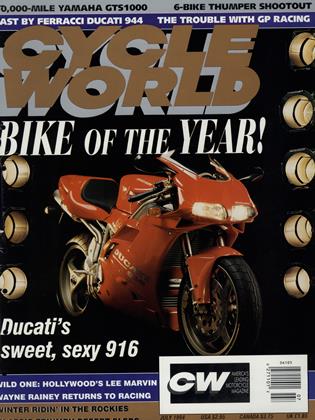GLORY DAYS
A FORMER RACER REMEMBERS THE CLEAN CHARM OF DIRTY DESERT SLEDS
IT’S DIFFICULT TO IMAGINE NOW THAT regulations seem more common in the wilderness than jackrabbits or sagebrush, but not too long ago the desert was a giant racetrack. Especially in the sandy hills of Southern California, where about 40 area racing clubs competed nearly every weekend, and so-called “desert sleds” ruled the region.
Mike Parti remembers that era well. A former racer with Four Aces Motorcycle Club, he recalls that race courses back then were difficult but the rules simple: Go out and beat the guy riding next to you. “There was no money, no grandstand, no applause,” he says. “It was the most honest type of racing.”
The bikes were just as honest, built to be ridden hard and put away wet. Desert sleds were usually based around Triumphs, and, as Cycle World described in 1967, the name “probably has its origin in the delightful scraping sensation one feels as the skidplate hits ground.”
Fifty-eight-year-old Parti no longer rides, but his personal collection of vintage desert racers includes several that he wrestled through events such as the grueling 500-mile Green Horn Enduro. Two of his favorites: the `64 Triumph TR6 and `60 Triumph side hack pictured here.
To ready his solo Triumph for the tough terrain, Parti modified the already meaty 650cc Twin with a 750 big-bore kit. A Bates seat with thick padding was designed to help the rider endure miles of rugged, rocky territory. Add a heavy-duty "Q" air cleaner by Buck Smith, magneto by Sam Bass, braced foot pegs and Bud Ekins exhaust pipes, and you had a bike ready to take on the desert.
The sidehack needed more signifi cant alterations. It was fitted with a Harley-Davidson fork and front wheel. Parti beefed up the engine with a Norton 750 crankshaft and connecting rods, then threw on a nine-bolt 650 Triumph head, "Q" air cleaner and home-made exhaust. He also built the sidecar himself, using a Matchless rear wheel, Bates seat and braced frame His hack survived the abuse of 20 racing seasons, from 1964-1984. For Patti, it holds special significance as the vehicle that helped propel him and his partner, Jim Moffit, to wins in the sidecar class in the 1965, `66 and `67 Barstow-to-Vegas races. "The start of the race was like an explosion, and then you were gone," he remem bers. "You learned to read the ter rain, to make snap decisions and follow your instincts. I knew I'd become a good racer when I felt more at home on my bike than I did walking around."
Parti has adeep appreciation for the dirtbikes of today, but he says that there will never be anything like the era when desert sleds were king.
"I feel sorry for the kids of today," he says. "They'll never be able to ride the way we did. There's a feel ing that you'd get, out in the middle of the desert by yourself. It was just you and the bike."
Nina Padgett














